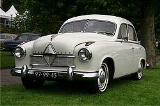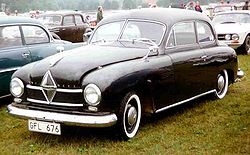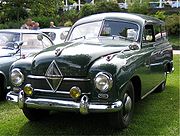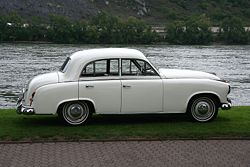
Borgward Hansa 1500
Encyclopedia




Bremen
The City Municipality of Bremen is a Hanseatic city in northwestern Germany. A commercial and industrial city with a major port on the river Weser, Bremen is part of the Bremen-Oldenburg metropolitan area . Bremen is the second most populous city in North Germany and tenth in Germany.Bremen is...
based auto-manufacturer Carl F. W. Borgward GmbH
Borgward
Borgward was a German automobile manufacturer founded by Carl F. W. Borgward . The company was based in Bremen...
. The strikingly modern car was presented at the Geneva Motor Show in March 1949. Production cars first rolled off the line on October 13 1949.
The Hansa was replaced by the Borgward Isabella
Borgward Isabella
The Borgward Isabella was a medium-sized, two-door saloon manufactured by the Bremen based auto-manufacturer Carl F. W. Borgward GmbH from 1954-1962...
in 1954.
It is often seen as the first all new model launched by the German auto industry after the war. Introduced nearly four years before the better remembered ’Ponton Mercedes’ the Hansa featured the then revolutionary ponton
Ponton (automobile)
Ponton or Pontoon styling refers to a 1930s-1960s design genre — ultimately the precursor of modern automotive styling. The trend emerged as distinct running boards and fully articulated fenders became less common and bodywork began to enclose the full width and uninterrupted length of a car...
, three-box
Three-box styling
Three-box design is a broad automotive styling term describing a coupé, sedan, notchback or hatchback where — when viewed in profile — principal volumes are articulated into three separate compartments or boxes: engine, passenger and cargo....
design that subsequently became mainstream in Germany and across much of Europe.
The body
The car was launched as a two- or four-door saloon with an all-steel body built around a central steel frame, which bears a resemblance to a 1949 Ford1949 Ford
After sticking with its well-received previous model through model year 1948, Ford completely redesigned its namesake car for 1949. Save for its drivetrain, this was an all-new car in every way, with a modern ladder frame now supporting a coil spring suspension in front and longitudinal...
. The wings were fully integrated into the bodywork, and the passenger cabin filled the full width of the car. At a time when competitor vehicles from Opel
Opel Olympia
The Opel Olympia is a small family car produced by the German automaker Opel from 1935 to 1940, from 1947 to 1953 and again from 1967 to 1970.The 1935 Olympia was Germany's first mass-produced car with an all-steel unitized body . This revolutionary technology reduced the weight of the car by 180...
and Mercedes Benz
Mercedes-Benz W136
The Mercedes-Benz W136 was Mercedes-Benz's line of four-cylinder automobiles from the mid-1930s into the 1950s. It became the foundation on which the company rebuilt after World War II because the tooling had survived Allied bombing....
were still based on conventional looking prewar designs, the interior width of the Hansa, emphasized by the inclusion of bench seat
Bench seat
The bench seat was the traditional seat installed in American automobiles. This seat featured a continuous pad running the full width of the cabin...
s both at the back and in the front, attracted favourable press comment. The car was seen as a genuine six-seater. Also noteworthy in 1949 was the separate lid that permitted the boot / trunk to be accessed from outside the car. At the other end, the bonnet / hood was hinged at the side and could be opened from either the left or the right side as necessary. Instead of traditional semaphore style direction indicators
Trafficators
Trafficators are semaphore signals which, when operated, protrude from the bodywork of a motor vehicle to indicate its intention to turn in the direction indicated by the pointing signal. Trafficators are often located at the door pillar.-History:...
, the Hansa featured flashing lights for use as direction indicators, the flashing being replicated within the tri-functional rear lights which included within a single unit rear lights and brake lights along with the US style flashing direction indicators.
The driver was faced by a steering wheel linked to its central boss by three sets of four thin spoke like rods. The design of the steering wheel, reminiscent of the early Porsches
Porsche 356
The Porsche 356 was the company's first production automobile. It was a lightweight and nimble handling rear-engine rear-wheel-drive 2 door sports car available in hardtop coupe and open configurations. Design innovations continued during the years of manufacture, contributing to its motorsports...
, ensured minimal disruption of the view of the instruments behind it. Also behind the steering wheel was the column-mounted gear lever.
A two-door estate version and a five-seater two-door cabriolet were available along with a two-seater sports cabriolet. The cabriolets were both assembled by the coach builders Hebmüller in Wülfrath
Wülfrath
Wülfrath is a town in the district of Mettmann , in North Rhine-Westphalia, Germany.-Geography:The town is situated on the mountain spurs of the Bergische Land, between the Rhine, Ruhr and Wupper rivers. It is located in the central part of the Berg region, approx...
until May 1952.
Engine, transmission and chassis
The Hansa was introduced with a 1498 cc four-cylinder ohv engine providing a claimed power output of 48 bhp (35 kW). For 1952 the engine was modified to produce 52 bhp (38 kW). A 66 bhp (49 kW) output version of this engine was installed in the sports cabriolet. The Borgward engine had an unusual design where the intake manifold was on top the engine and came through the valve cover, along with the carburettor. Bill Blydenstein tuned several of these engines for racing with some success.The column-mounted gear lever controlled a three-speed gear box
Manual transmission
A manual transmission, also known as a manual gearbox or standard transmission is a type of transmission used in motor vehicle applications...
.
The wheels were independently sprung, the rear wheels being attached to a swing axle and supported by springs with hydraulic shock absorbers. All four wheels were connected to the foot brake via a hydraulic system, while the hand brake was a mechanical one operating on the rear wheels.
More power
1952 saw the introduction of the faster Borgward Hansa 1800, with a 1758 cc 4-cylinder engine producing 60 bhp (44 kW). The Hansa 1800 benefited from a four-speed gear box, with synchromesh between the top two ratios. The front direction indicators which on the Hansa 1500 had been located beneath the headlights, now migrated to the top of the front wings on the Hansa 1800.As before, the two- and four-door saloons were complemented by cabriolet and estate versions.
The next year the Hansa 1800 became available with a diesel engine of the same capacity as the petrol / gasoline fuelled unit, but with a power output of 42 bhp (31 kW).
An 1800 diesel saloon version tested by the British The Motor
The Motor (magazine)
The Motor was a British weekly car magazine founded on 28 January 1903....
magazine in 1954 had a top speed of 68 mph (109.4 km/h) and could accelerate from 0-50 mph (80.5 km/h) in 27.9 seconds. A fuel consumption of 45.6 mpgimp was recorded. The test car cost £1493 including taxes in the United Kingdom.

